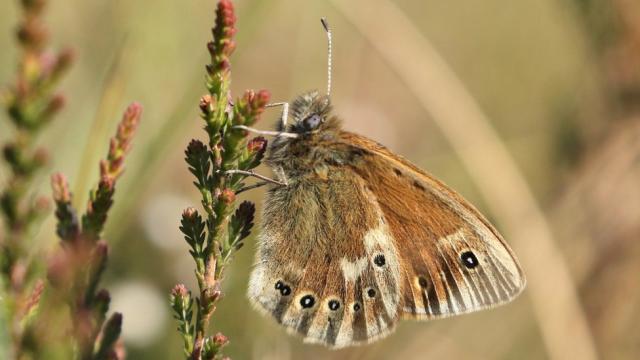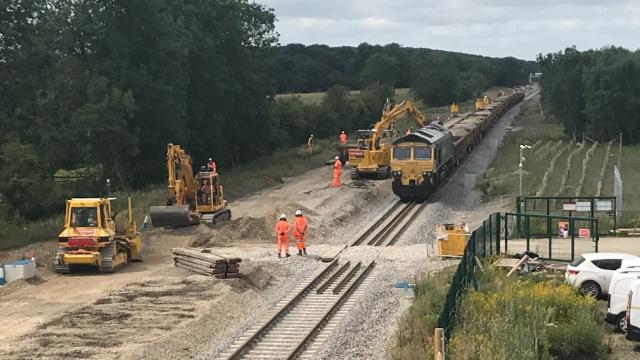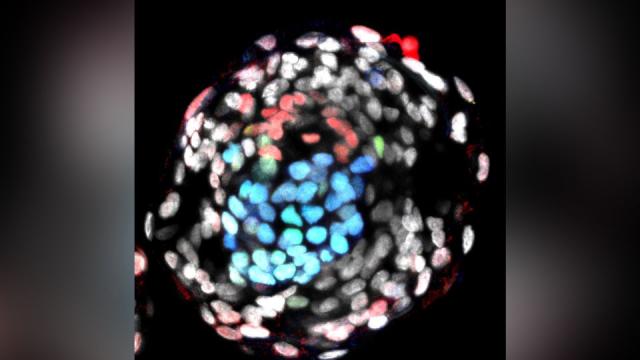Science Daily News | 16 Jun 2023

Views (143)

East West Rail: Campaigners fear rare species will be lost forever
The team behind the East West Rail link must consider its environmental impact, campaigners say.

Cutting a new railway line through the Bedfordshire and Cambridgeshire countryside could see many rare species disappear from the area, according to local campaigners. How has the team behind East West Rail (EWR) mitigated against the environmental impact of the scheme?
A spokesman for the £5bn railway line between Cambridge and Oxford said the chosen route would offer an "environmentally sustainable solution".
The campaign aims to "influence the government, Bedford Borough Council and East West Rail to reconsider this environmentally destructive route".
"My main concern, from a local point of view, is the destruction of the countryside," she says.
"This is an ancient woodland and a county wildlife site, which would be dramatically impacted if the route goes ahead.
"It's a bluebell wood - the local wildlife corridors would be disrupted. Once they've gone, they've gone - these animals don't come back."
In particular, she says, birds on the RSPB Red List, such as the ground-nesting skylark, are "really at risk through habitat destruction and encroachment".
She says EWR is "paying lip service" and that a flatter, shorter route suggested by BFARE has been "disregarded".
"I would like to see our experts meet their experts and have a free and frank discussion," she says.
"The railway did exist in the 50s and 60s, but the whole railway footprint became overgrown and a natural habitat for lots of rare species like bats and great crested newts," he says.
"We've got to protect those species and habitats and work very closely with the regulator to get the correct licenses in terms of how we carry out the work."
"We do a lot of surveys to identify where the habitats are living - and then we keep surveying through the life of the project and beyond the completion of the project to make sure those habitats are thriving and surviving," he adds.
"What we've seen so far is that all our compensation sites are being used by the various habitats and we've not seen any failures in those local populations.
"What we've learned will be taken forward for the later phases of EWR."
He said they were also working to protect local badger setts and creating more than 30 breeding sites for the mammals.
In its latest proposals, published in May, the East West Rail Company committed to a target of 10% biodiversity net gain across the whole project.
It said many of the sites have been "transformed from low diversity, arable land into purpose-built wildlife havens designed to benefit invertebrates, butterflies, birds, bats, reptiles and amphibians, otters and badgers".
Chief executive officer Beth West said: "We're doing everything we can to minimise the environmental impact that we're having, both in terms of construction and in the route itself.
"So we're not going through any ancient woodland. We're going to have a 10% biodiversity net gain, which means that any impact that we, have there will be 10% more than what we started with."
When farmer Tim Scott's land at Comberton, Cambridgeshire, was acquired 23 years ago, it was a "blank canvas", he says.
"In those 23 years, we've put in miles of hedgerows, miles of grass margins - and it is teeming with wildlife."
It was among the top areas of the country for Red List revival of birds such as grey partridge, linnet, yellowhammer and corn bunting.
"The main fear here is the land is very narrow and the impact of the railway line on this Westfield farm would be enormous," he adds.
"It's okay putting a railway line and planting a few trees, but for species that like living in open farmland, that isn't going to work.
"Hundreds of volunteers over the years have done so much to improve the biodiversity and it will all be lost forever - it's a crying shame.
"It would appear EWR is totally ambivalent to the countryside in general. The project is ill thought-out and unpopular."
Scientists report creation of first human synthetic model embryos
A team of researchers in the United States and United Kingdom say they have created the world’s first synthetic human embryo-like structures from stem cells, bypassing the need for eggs and sperm.

A team of researchers in the United States and United Kingdom say they have created the world’s first synthetic human embryo-like structures from stem cells, bypassing the need for eggs and sperm.
These embryo-like structures are at the very earliest stages of human development: They don’t have a beating heart or a brain, for example. But scientists say they could one day help advance the understanding of genetic diseases or the causes of miscarriages.
The research raises critical legal and ethical questions, and many countries, including the US, don’t have laws governing the creation or treatment of synthetic embryos.
The pace of discoveries in this field and the growing sophistication of these models have alarmed bioethics experts as they push ever closer to the edge of life.
“Unlike human embryos arising from in vitro fertilization (IVF), where there is an established legal framework, there are currently no clear regulations governing stem cell derived models of human embryos. There is an urgent need for regulations to provide a framework for the creation and use of stem cell derived models of human embryos,” James Briscoe, associate research director at the Francis Crick Institute, said in a statement.
Dr. Magdalena Zernicka-Goetz described the work in a presentation Wednesday to the International Society for Stem Cell Research’s annual meeting in Boston. Zernicka-Goetz, a professor of biology and biological engineering at CalTech and the University of Cambridge, said the research has been accepted at a well-regarded scientific journal but has not been published. The research was first reported by The Guardian.
The embryo-like structures that Zernicka-Goetz says her lab has created were grown from single human embryonic stem cells that were coaxed to develop into three distinct tissue layers, she said. They include cells that would typically go on to develop a yolk sac, a placenta and the embryo itself.
She told CNN that the embryo-like structures her lab has created are also the first to have germ cells that would go on to develop into egg and sperm.
“I just wish to stress that they are not human embryos,” Zernicka-Goetz said. “They are embryo models, but they are very exciting because they are very looking similar to human embryos and very important path towards discovery of why so many pregnancies fail, as the majority of the pregnancies fail around the time of the development at which we build these embryo-like structures.”
She said that to her knowledge, it was the first time a human model embryo had been created with three tissue layers. But she stressed that while it mimics some of the features of a natural embryo, it doesn’t have all of them.
Right now, the synthetic model human embryos are confined to test tubes. It would be illegal to implant one in a womb, and animal research with stem cells from mice and monkeys has shown that even when scientists have attempted to implant them, they don’t survive – probably because researchers haven’t figured out how to fully replicate the conditions of pregnancy.
Zernicka-Goetz said that the aim of her research wasn’t to create life but to prevent its loss, understanding why embryos sometime fail to develop after fertilization and implantation.
“We know remarkably little about this step in human development, but it is a time where many pregnancies are lost, especially in an IVF setting,” Roger Sturmey, senior research fellow in maternal and fetal health at the University of Manchester in the UK, said in a statement.
“Currently, we can say that these ‘synthetic embryos’ share a number of features with blastocysts, but it is important to recognise that the way that synthetic embryos are formed is different to what happens when a normal embryo forms a blastocyst,” he said. “There is much work to be done to determine the similarities and differences between synthetic embryos and embryos that form from the union of an egg and a sperm.”
NASA rover "postcard" shows Mars during different times of the day
The panoramic postcard shows multiple landmarks on the planet.

NASA's Mars rover, Curiosity, recently captured a stunning photo of the Martian skies and landscape that offers researchers a glimpse at what the red planet looks like at different times of day.
Once in the hands of NASA scientists, the photos were turned into panoramic images. Color was also added to the photos, creating what NASA referred to as a "postcard," and further emphasizing the difference between the two times the photos were taken.
The photo also shows Curiosity itself and captures the rover's tracks across the dusty Martian landscape.
Images without the added color remain striking: The black-and-white photos each show the same scene, but with deepening shadows on each side. In the morning images, the shadows are on the left.
In the afternoon photos, the shadows come from the right side, and the entire image appears darker.
NASA noted that it was winter at the time the rover took these photos. During this time of the year on Mars, shadows are deeper and darker because dust levels in the Martian atmosphere are at their lowest.
"Mars' shadows get sharper and deeper when there's low dust and softer when there's lots of dust," Ellison said.
The Curiosity rover, which is the size of an SUV, is working to search for conditions, past or present, favorable for life on the planet. The rover was built by NASA's Jet Propulsion Laboratory, which manages Curiosity's mission.
Iceland Ireland told to recall UK products 'of animal origin'
The Food Safety Authority of Ireland has directed the withdrawal of frozen foods of an animal nature.

The Food Safety Authority of Ireland (FSAI) has served a notice on Iceland Ireland for the immediate withdrawal of imported frozen food of animal origin.
The notice to Metron Stores Ltd applies to products imported into the Republic of Ireland since 3 March.
In addition, the FSAI is directing the company to recall affected products and is advising consumers not to eat any of the implicated food.
The authority said there was "inadequate evidence of traceability" of imported frozen food from the retailer.
"Some frozen food of animal origin has been imported into Ireland without pre-notification and completion of entry declarations and health certificates since 3 March 2023," the FSAI said in a statement.
"Discussions with the company have taken place and the investigation involves the FSAI; the Environmental Health Service of the Health Service Executive; the Department of Agriculture, Food and the Marine (DAFM); the Sea-Fisheries Protection Authority."
Consignments of food were detained at Dublin Port and a notice was issued to either return the products to Britain or destroy them, the FSAI said.
Foods of animal origin are any products that contain ingredients that come from an animal, such as meat, fish, eggs and dairy products.
"All food businesses must also have full traceability information on the food they are importing, producing, distributing and selling," she said.
"Due to these breaches of food legislation and in the interest of consumer protection, this action has been taken.”
As part of the investigation, the FSAI has informed the European Commission, the Food Standards Agency UK, Food Standards Agency Northern Ireland, and Food Standards Scotland.
Private space station: How Axiom Space plans to build its orbital outpost
Axiom Space is using the results of science experiments conducted on its private missions aboard the International Space Station to inform the design and use of the company's own orbital laboratory.

Axiom Space has big plans for low Earth orbit.
In the meantime, Axiom is using data provided by its crewed missions to the ISS to guide the form and function of the space station modules the company is building. "Each of these precursor missions for us is a learning opportunity on how we become a better human spaceflight company," said Tejpaul Bhatia, Axiom's chief revenue officer.
These first missions are also helping to lay the foundations for Axiom's training programs going forward. "We are using these first missions as a way to understand how to train astronauts, train crew, and really have the operational expertise that we need as an entire company, but also to kind of fine-tune the things that we want to fly from a low-Earth-orbit economy perspective," Zuniga told Space.com.
Axiom wants its space station to provide maximum value to its passengers, and one main goal of these initial crewed missions to the ISS is to determine where that value will be.
"It's more about making sure that we understand the needs of our future crews so that we're tailoring our space station to do those things," Zuniga said. "Is it going to be the microgravity research? Or is it going to be in space manufacturing, etc.? Those are the primary goals for flying these precursor missions.
"In doing that, it gets all our people exposed to how we actually operate and build a station that will be operable in the future," he added. "Thinking about the amount of crew activity that goes on, thinking about the amount of operational space that a crewmember has to apply to a space station so that they can keep it up and flying and maintaining it — all those things are really important in understanding how we design our future space station."
Axiom is also taking notes directly from NASA on how to build space stations. "Our team is well versed in human spaceflight," Zuniga said. "We've just been able to kind of pull the talent that we needed from folks who have built and designed space stations."
In doing so, the company has kept an eye toward the future. "We're working with NASA to make sure that we follow all the requirements that the ISS has today, so that we can build our models for the future to those requirements," Zuniga said. "All of that is also giving us exposure to make sure that we design our space station so that it's compatible to today's standards, but also has a vision to the future and how we want to use space stations for people that will fly privately."
RELATED STORIES:
Rare butterflies thriving after reintroduction bid
Experts say they are excited to bring the Manchester argus butterfly back to the city.

A rare butterfly that once thrived in the peatlands of Greater Manchester is now "flourishing" after being reintroduced in 2020, experts say.
The large heath butterfly was once so widespread that it was locally named the Manchester argus.
But its habitat was wrecked by the 19th Century arrival of the Liverpool and Manchester Railway.
Wildlife experts said they were "optimistic" about the species, which is now "breeding strongly".
It followed the restoration of drained peat and vegetation.
Jo Kennedy, co-ordinator at Great Manchester Wetlands Partnership, said: "More than 98% of lowland peatlands in our region have been lost, creating a huge hole in our biodiversity."
She said experts - including Chester Zoo, Manchester Metropolitan University and Natural England - were "excited to be able to bring the Manchester argus back to Manchester".
"It's been a real team effort but, with three releases of butterflies now achieved, the population is breeding strongly and we are really optimistic about its future."
The butterflies were reintroduced after six pregnant females were collected under licence from an existing population at Winmarleigh Moss near Garstang, Lancashire.
Chester Zoo staff then cared for the butterflies while they laid eggs, before the caterpillars were released.
The precise locations of the reintroductions have not been revealed to help protect the butterflies.
Helen Bradshaw, from Chester Zoo, said the reintroduction was "part of our mission in preventing extinction worldwide".
"We're thrilled to see the remarkable resurgence of these rare butterflies in their native habitat after years of hard work and dedication.
"When reintroductions are done right like this they can be hugely successful."
The argus butterfly
The argus butterfly (aricia agestis) once thrived in the UK but declined due to changes in agricultural methods.
The species inhabit boggy peatlands and is very sedentary, rarely moving more than 100m during its entire life.
Their caterpillars are capable of surviving long periods of hibernation.
The cocoons hang from plants and are green with black stripes, allowing them to camouflage and avoid predators.
Surviving populations have existed in Scotland and northern England.
Sources: Lancashire Wildlife Trust, South West Scotland Butterfly Conservation, UK Butterflies and the Forestry Commission
0 Likes
